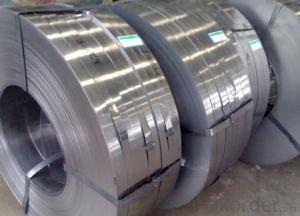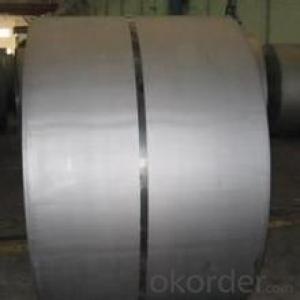cold rolled steel coil and sheets full hard
- Loading Port:
- Tianjin
- Payment Terms:
- TT OR LC
- Min Order Qty:
- 5 m.t.
- Supply Capability:
- 5000 m.t./month
OKorder Service Pledge
OKorder Financial Service
You Might Also Like
Quick Details
| Standard: | AISI,ASTM,BS,DIN,GB,JIS,BS1387-85,GB/T3091-08,DIN2440,JIS-G3444,EN10255,ASTM A53, | Steel Grade: | GRA. GR.B.SGCC.SPCC.SPHC.DX510 | Thickness: | 0.17-1.5mm |
| Place of Origin: | TIA,Tianjin,China China (Mainland) | Technique: | hot rolled or cold rolled | Surface Treatment: | Galvanized Polished or Colour coated,zinc coated or colour coated |
| Application: | used to building material/ roof/ profile/ pipe making | Model Number: | according to your requirement | Brand Name: |
|
| Width: | 600-1550mm | Length: | enough meter per ton or according to your requirement | Delivery time: | Within 20 days after the prepayment |
| Certtificate: | ISO9000-2008, BV | HS Code: | 7306309000 | Usage: | Scaffolding pipe, Structure pipe, Fence/Door pipe, Furniture, |
| Supply Ability: | 12000MTS/Month | Payment terms: | T/T;L/C;D/P | MOQ: | 10MTS |
Packaging & Delivery
| Packaging Detail: | In bundles with steel strips |
| Delivery Detail: | About 20 days |
Specifications
1. Thickness: 0.12-1.5mm
2. Coil wideth: 600-1550mm
3. 60g-280g/m2
4. delivery in t
Thickness | 0.12-1.2mm |
Width | 600-1250mm |
Single weight | as your required |
Surface finished | 60-200g/m2 |
Steel gardes | SGCC SGCD DX51D+Z SGC340 SGC400 SGC44O DC51D+Z |
Standard | JIS G3302,ASTM A653, GB/T2518-88,BS, |
Packing | standard export packing |
Used | Use for profile,pipe making, furniture makingppgi and refrigerator |
Minimum quantity | 25MT |
Price | USD600-800 MT |
Delivery time | within 30 days after receiving L/C or after 30% depost |
Payment terms | T/T or L/C |
Supply ability | 13,000MT per month |
- Q:How are steel coils tested for strength?
- Steel coils are tested for strength through a process called tensile testing. In this test, a small sample of the steel coil is pulled until it breaks, allowing engineers to measure the maximum force the coil can withstand before failing. This helps determine the overall strength and quality of the steel coil.
- Q:Can steel coils be coated with anti-fingerprint materials?
- Yes, steel coils can be coated with anti-fingerprint materials. These coatings are designed to minimize fingerprint smudging and make the surface easier to clean, improving the appearance and functionality of the steel coils.
- Q:Does aluminum or steel hold up better? We found a steel for 1/2 the price of aluminum, obviously its heavier but any other downsides? rust faster ect? also, does anybody know, in PA do you pay sales tax on trailers? and do dealers normally give you license plates to get the trailer home with? we live 3 hours away from the dealer so thats why i want all details :) would stink if i messed up!!
- We have an aluminum trailer over a steel frame. We used to have a steel trailer. There are two differences I see are the weight and how quickly they deteriorate. I personally prefer the aluminum over the steel, the upkeep is easier and they don't weigh as much which equates to fuel savings. Also if you have a lighter truck an aluminum trailer makes the wear and tear a little easier. You can also look at the size of the truck you are going to tow the trailer with, and the size of the horses inside. All together you definately don't want to exceed the weight limits of the truck. Hope this helps...
- Q:so why shouldn't one use a steel cased 223 in an ar15?
- Because some people ***** and moan about how the lacquer or polymer gums up the chamber causing torn case rims. But they don't clean there guns anyway so there point is irrelevant. Some say it wears out your extractor faster which is also bullshit. The steel casings are a milder bi-metal. Really its people complaining for the sake of complaining.
- Q:How are steel coils used in the production of steel beams?
- The production of steel beams requires the use of steel coils, which are a vital element in the process. Typically, these coils are created by hot rolling steel strips in a continuous manner. Subsequently, the coils are transported to a steel beam manufacturing facility for further processing. To begin with, the steel coils are unraveled and flattened in order to achieve a flat surface. This step ensures that the dimensions of the beam are uniform and enhances the overall quality. The uncoiling process involves passing the coil through a series of rollers, which gradually unwind the steel strip. Once the steel strip has been unraveled, it is then divided into specific lengths based on the desired size of the steel beams. Generally, this cutting process is executed using automated machinery, which guarantees precision and accuracy. Following that, the cut steel strips are shaped to match the desired profile of the steel beams. This is accomplished through a technique known as roll forming, in which the steel strip is passed through a sequence of rollers that progressively bend and shape it to the required form. The roll forming process enables the creation of various types of steel beams, including I-beams, H-beams, and U-beams, depending on the design and structural requirements. After the roll forming process, the steel beams undergo additional finishing operations, such as straightening, welding, and surface treatment. Straightening ensures that the beams are perfectly aligned and devoid of any deformities. Welding is performed to connect different sections of the beams, ensuring their structural integrity. Finally, the beams are subjected to surface treatment, typically involving methods such as shot blasting or painting, to safeguard against corrosion and enhance their aesthetic appearance. In conclusion, steel coils play a critical role in the production of steel beams, serving as the essential raw material that undergoes uncoiling, cutting, shaping, and further processing. These high-quality steel beams find extensive application in diverse construction projects, encompassing buildings, bridges, and industrial structures, thereby cementing their status as an indispensable component within the construction industry.
- Q:How are steel coils used in the manufacturing of machinery?
- Steel coils are used in the manufacturing of machinery as they serve as a primary material for various components such as gears, shafts, frames, and structural supports. These coils are typically cut, shaped, and welded to form intricate and durable parts that can withstand the demands of heavy-duty machinery. Additionally, the strength, versatility, and corrosion resistance of steel make it an ideal choice for machinery manufacturing, ensuring longevity and reliability in the final product.
- Q:I have a bottle like this* Can u make hot chocolate in it. Can i heat it.I wanna take hot Chocolate to school
- Stainless Steel Water Can
- Q:What are the challenges in coil blanking?
- Coil blanking, a process used to cut flat metal sheets from coiled stock, presents several challenges that need to be addressed for efficient and accurate production. Some of the key challenges in coil blanking include: 1. Material variations: Coiled stock can have variations in thickness, width, and surface quality. These variations can affect the cutting process and result in inconsistent blanks. Proper material selection and control are crucial to ensure consistent quality and dimensional accuracy. 2. Coil set and crossbow: Coiled stock often has inherent shape imperfections like coil set (longitudinal curvature) and crossbow (transverse curvature). These imperfections can cause alignment issues during the cutting process, leading to misalignment and inaccurate blanks. Specialized equipment and techniques, such as straighteners and leveling systems, are required to minimize these shape imperfections. 3. Coil edge condition: The edges of coiled stock can have burrs, waves, or irregularities, which can affect the quality and precision of the cut blanks. Adequate edge conditioning techniques, such as deburring or edge trimming, need to be employed to ensure clean and straight edges for the final blanks. 4. Slitting and shearing forces: The forces exerted during the coil blanking process can induce stresses and strains in the material, potentially leading to deformation or springback. These factors can result in dimensional variations and affect the overall quality of the finished blanks. Careful consideration of the slitting and shearing forces, along with proper tooling design and machine settings, is necessary to minimize these effects. 5. Scrap and material waste: Coil blanking can generate significant amounts of scrap material, especially during setup and adjustment phases. Managing scrap and minimizing material waste are critical challenges in coil blanking to optimize production efficiency and reduce costs. Efficient nesting algorithms and real-time monitoring systems can help optimize material utilization and minimize waste. 6. Automation and productivity: Coil blanking processes often require high-speed and high-volume production to meet market demands. Implementing automation systems, such as robotic material handling and advanced control systems, can enhance productivity. However, integrating and synchronizing these automation components with the cutting process can be challenging and requires careful planning and system integration expertise. Overall, addressing these challenges in coil blanking requires a combination of proper material selection, advanced equipment, specialized techniques, and efficient process control. By overcoming these challenges, manufacturers can achieve consistent quality, dimensional accuracy, and productivity in coil blanking operations.
- Q:How are steel coils used in the production of automotive engine components?
- Steel coils are used in the production of automotive engine components by being processed and shaped into various parts, such as pistons, crankshafts, and connecting rods. The coils are first cut, stamped, and formed into the desired shapes, and then undergo heat treatment and other machining processes to enhance their strength and durability. These components are crucial for the proper functioning of an automotive engine, as they provide structural support and help convert the energy generated by the combustion process into mechanical motion.
- Q:What is the role of steel coils in the production of conveyors?
- Steel coils play a crucial role in the production of conveyors as they are used to create the framework or structure of the conveyor belts. The coils are formed into a continuous loop, which provides strength, durability, and flexibility to the conveyor belts. Additionally, the steel coils ensure smooth movement and support heavy loads, making them essential components in conveyor manufacturing.
1. Manufacturer Overview |
|
|---|---|
| Location | |
| Year Established | |
| Annual Output Value | |
| Main Markets | |
| Company Certifications | |
2. Manufacturer Certificates |
|
|---|---|
| a) Certification Name | |
| Range | |
| Reference | |
| Validity Period | |
3. Manufacturer Capability |
|
|---|---|
| a)Trade Capacity | |
| Nearest Port | |
| Export Percentage | |
| No.of Employees in Trade Department | |
| Language Spoken: | |
| b)Factory Information | |
| Factory Size: | |
| No. of Production Lines | |
| Contract Manufacturing | |
| Product Price Range | |
Send your message to us
cold rolled steel coil and sheets full hard
- Loading Port:
- Tianjin
- Payment Terms:
- TT OR LC
- Min Order Qty:
- 5 m.t.
- Supply Capability:
- 5000 m.t./month
OKorder Service Pledge
OKorder Financial Service
Similar products
New products
Hot products
Related keywords





























